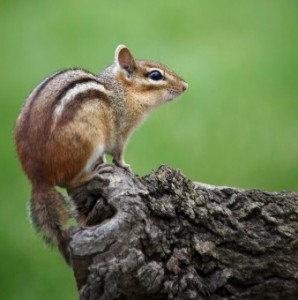 From Alvin, Simon and Theodore to Chip and Dale, there are few wild animals that are portrayed as cute and as cuddly as the Eastern chipmunk. When you consider their chubby cheeks, intelligent eyes and telltale striped markings, along with their cheerful calls, it’s hard to imagine them as anything but. Some people have even tamed chipmunks to the point where they can hand-feed them (although we never recommend that you attempt to tame any form of wildlife), but what lies beneath their adorable surface? We’ll share with you a few facts on the Eastern chipmunk from the SUNY College of Environmental Science and Forestry (ESF).
From Alvin, Simon and Theodore to Chip and Dale, there are few wild animals that are portrayed as cute and as cuddly as the Eastern chipmunk. When you consider their chubby cheeks, intelligent eyes and telltale striped markings, along with their cheerful calls, it’s hard to imagine them as anything but. Some people have even tamed chipmunks to the point where they can hand-feed them (although we never recommend that you attempt to tame any form of wildlife), but what lies beneath their adorable surface? We’ll share with you a few facts on the Eastern chipmunk from the SUNY College of Environmental Science and Forestry (ESF).
The Eastern chipmunk is found all throughout the Adirondacks, but can be found from Canada all the way to the Gulf of Mexico. It likes to live in hardwood forests (like maple and beech) and constructs a vast burrow system beneath the forest floor. Generally speaking, the chipmunk digs only part of the system, and renovates the abandoned root channels and burrows of other animals as the main portion of the system. There are deeper tunnels constructed to mitigate flooding of the nest and food hoard areas. There is a secondary entrance that the clever, resourceful rodent plugs with leaves.
The Adirondacks make a perfect foraging ground for the Eastern chipmunk as well. The forest provides a seasonal supply of many of the staples of the chipmunk’s diet, including maple seeds, beechnuts, black cherries, yellow trout lily bulbs as well as many other fruits, nuts and fungi. According to the ESF, the Eastern chipmunk can stuff as many as 32 beechnuts (their food of choice) in their cheeks at once, and generally store between 5000 and 6000 nuts for winter use. A common misconception about the chipmunk, however, is that they’re entirely herbivores. Chipmunks also eat invertebrates (like bugs), small vertebrates (like salamanders and peepers), and occasionally birds, especially nestlings!
While the Eastern chipmunk spends most of winter in its den, it’s not considered to be a true hibernator. That’s because it wakes from short, deep sleep sessions to eat the cache of nuts and seeds it has stored. Chipmunks occasionally leave their burrows to forage for food, even when the snow is deep. If the chipmunk dwells in a residential area, it may leave the winter nest to enjoy some treats from neighborhood bird feeders. Year-round, chipmunks are day-dwellers and do not leave their burrows at night. Their main period of inactivity is during the hottest months of the year, and may rarely leave their nests during those months.
Chipmunk moms usually have two to nine pups, and she weans and abandons them once they come above ground. Chipmunks can live to be eight years old, but many only survive two to three years because of the abundance of natural predators they have, which include owls, hawks, coyotes, foxes, martens, fishers, bobcats, raccoons and red squirrels. (We know a few housecats who have “rewarded” their owners with the occasional chipmunk as well.) Chipmunks are usually solitary and do not mate for life. They defend their territory, and may take a bite out of a challenger!
While in reality the Eastern chipmunk may be a far cry from its cartoon counterpart, these woodland creatures are still fun to watch and are abundant throughout the Adirondacks. So sit back and enjoy their antics the next time you’re hiking through the Adirondack forest, but remember – like all other wildlife they enjoy living in their own habitat, and they can certainly bite when provoked! To learn more about the Eastern chipmunk, visit the ESF at https://www.esf.edu/aec/adks/mammals/chipmunk.htm.